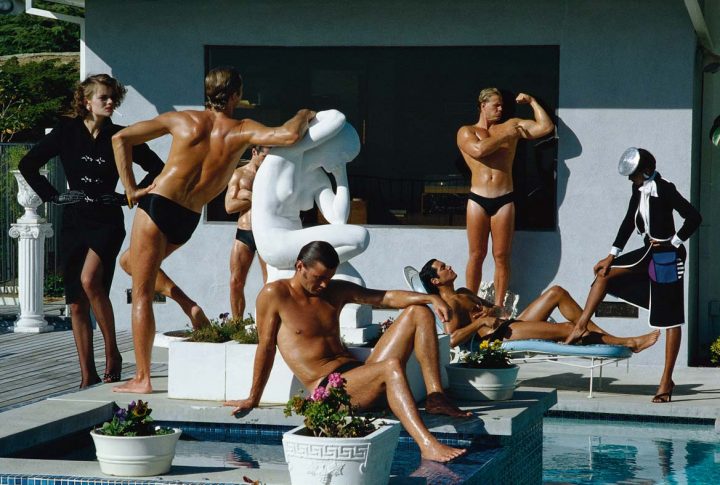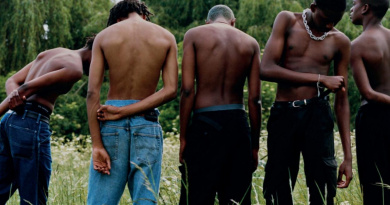After his permanent position at French Vogue in 1961, Helmut Newton also worked in parallel for the American edition of the fashion magazine. Some of these photographs were taken in Europe, others in the USA. In New York, Newton delivered his images directly to Alexander Liberman, who headed American Vogue from the 1960s to the 1990s - and worked very successfully as a painter, sculptor and photographer on the side. Newton liked the United States and the proverbial freedom in those years, so he regularly shuttled back and forth between the Old and New Worlds. In the 1970s Newton photographed fashion and nudes in America, especially in New York, Las Vegas, Miami or Los Angeles; these shots were published in various magazines as well as partly in his second illustrated book ("Sleepless Nights", 1978). After 1980, when Helmut and June Newton regularly traveled to Los Angeles to spend the winter months at the Chateau Marmont, numerous portraits of the 'famous and infamous' in and around Hollywood were added, taken for magazines such as Egoïste, Interview, Vanity Fair or New Yorker, as well as some nudes for Playboy. The focus within the exhibition clearly shows that Newton's visual language changed during his work in the U.S. during these years, and that the genre of portraiture in particular became increasingly important to him.
Roughly parallel to the Newton images on view were the portraits of Joel Meyerowitz in Provincetown, Massachusetts. The photographer retreated from New York to the former idyllic fishing village every summer in the late 1970s and early 1980s - and there he used his large-format camera to take portraits, mostly plein air, of like-minded free spirits who were also seeking summer retreats, seaside recreation, and nature, men and women, young and old, alone or as a couple. We see intense and curious glances back at the camera and only a few poses; the people, including numerous friends and acquaintances of Meyerowitz, appear open, undisguised, authentic. The large-scale portrait series had no client at the time; it was a free project. The result is a fascinating social portrait of a liberal, individualistic community on the American East Coast. It shows a different, freer, sometimes more permissive America than we know it today. Meyerowitz recently rediscovered these portraits in his archive, and a selection has been published for the first time in book form in the fall of 2019 - and will now be publicly exhibited for the first time at the Helmut Newton Foundation.
The American photographer Sheila Metzner shared a very close friendship with Helmut and June Newton. The mutual, previously unpublished portraits from the south of France, which are spread out in two showcases in the exhibition, bear witness to this special relationship. In her work, Sheila Metzner arranges otherwise minimalist things on an equally minimalist stage as pure form; in the photographic close-up, they seem like an apparition of themselves, condensed as a metaphysical essence. The delicate toning of the photographs, created as Fresson prints reminiscent of bromine oil prints by the avant-garde artists of the 1910s, transports the pictorial content, the floral and artistic forms, into the realm of daydream. But people also appear repeatedly in Sheila Metzner's work, be they her own five children, female and male models, for instance for her refined fashion stagings, or naked, odalisque beauties. Metzner, who still lives in New York, visited Joel Meyerowitz in Provincetown in the late 1970s and was portrayed by him there, as we see here. Thus, in this exhibition, which corresponds to a kind of time travel to a progressive and cool America, a circle is closed several times.
Finally, June's Room presents 30 photographs by Evelyn Hofer taken in New York in the 1960s and 70s, a kind of subjective city portrait with street scenes and panoramas, interiors and portraits, in black and white and color. In particular, her subtle color images of everyday life in New York, executed using the DyeTransfer process, are, alongside those of Saul Leiter or Helen Levitt, pioneering achievements of a poetic, magical realism in street photography that would shape subsequent generations of photographers. Hofer was born in Germany, left her home country with her family in 1933 for Madrid, later for Paris, Zurich and Mexico, and finally moved to New York in 1946. There she worked on assignment for fashion magazines, among others, and freely on her own book projects, always with a large-format plate camera and tripod. This resulted in a deliberate, concentrated and slow work that excluded spontaneous reactions in front of and behind the camera.
Since October 9, 2020, the Helmut Newton Foundation in Berlin presents its new exhibition "America 1970s/80s" with works by Evelyn Hofer, Sheila Metzner, Joel Meyerowitz and Helmut Newton.
Museum für Fotografie
Jebensstrasse 2 | D – 10623 Berlin
till 10. October 2021

Helmut Newton, Stern, Los Angeles 1980, copyright Helmut Newton Estate









